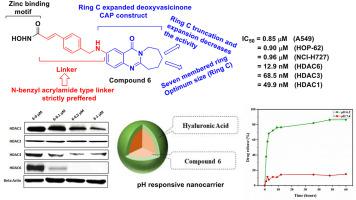European Journal of Medicinal Chemistry ( IF 6.7 ) Pub Date : 2022-07-13 , DOI: 10.1016/j.ejmech.2022.114602 Ram Sharma, Esha Chatterjee, Jacob Mathew, Sachin Sharma, N. Vijayakameswara Rao, Chun-Hsu Pan, Sung-Bau Lee, Ashwani Dhingra, Ajmer S. Grewal, Jing Ping Liou, Santosh K. Guru, Kunal Nepali

|
A fragment recruitment process was conducted to pinpoint a suitable fragment for installation in the HDAC inhibitory template to furnish agents endowed with the potential to treat lung cancer. Resultantly, Ring C expanded deoxyvasicinone was selected as an appropriate surface recognition part that was accommodated in the HDAC three-component model. Delightfully, fused quinazolinone 6 demonstrating a magnificent anticancer profile against KRAS and EGFR mutant lung cancer cell lines (IC50 = 0.80–0.96 μM) was identified. Results of the mechanistic studies confirmed that the cell growth inhibitory effects of compound 6 stems for HDAC6 (IC50 = 12.9 nM), HDAC1 (IC50 = 49.9 nM) and HDAC3 inhibition (IC50 = 68.5 nM), respectively. Compound 6 also suppressed the colony formation ability of A549 cells, induced apoptosis, and increased autophagic flux. Key interactions of HDAC inhibitor 6 within the active site of HDAC isoforms were figured out through molecular modeling studies. Furthermore, a pH-responsive nanocarrier (Hyaluronic acid - fused quinazolinone 6 nanoparticles) was designed and assessed using a dialysis bag approach under both normal and acidic circumstances that confirmed the pH-sensitive nature of NPs. Delightfully, the nanoparticles demonstrated selective cell viability reduction potential towards the lung cancer cell lines (A549 lung cancer cell lines) and were found to be largely devoid of cell growth inhibitory effects under normal settings (L929, mouse fibroblast cells).
中文翻译:

在 HDAC 抑制药效团中 C 环扩展的 deoxyvasicinone 的调节最终成为一种易于处理的抗肺癌剂和 pH 响应纳米载体
进行片段募集过程以确定合适的片段以安装在 HDAC 抑制模板中,以提供具有治疗肺癌潜力的药剂。结果,环 C 扩展 deoxyvasicinone 被选为适用于 HDAC 三组分模型的适当表面识别部分。令人高兴的是,融合的喹唑啉酮 6 对 KRAS 和 EGFR 突变肺癌细胞系 (IC 50 = 0.80–0.96 μM) 具有出色的抗癌作用。机理研究结果证实,化合物 6 茎对 HDAC6 (IC 50 = 12.9 nM)、HDAC1 (IC 50 = 49.9 nM) 和 HDAC3 抑制 (IC 50 ) 的细胞生长抑制作用 = 68.5 nM),分别。化合物 6 还抑制 A549 细胞的集落形成能力、诱导细胞凋亡和增加自噬通量。HDAC 抑制剂 6 在 HDAC 同种型的活性位点内的关键相互作用通过分子模型研究确定。此外,设计了一种 pH 响应纳米载体(透明质酸 - 融合的喹唑啉酮 6 纳米颗粒),并在正常和酸性环境下使用透析袋方法进行了评估,证实了 NPs 的 pH 敏感性。令人高兴的是,纳米颗粒对肺癌细胞系(A549 肺癌细胞系)表现出选择性降低细胞活力的潜力,并且发现在正常环境下(L929,小鼠成纤维细胞)基本上没有细胞生长抑制作用。


























 京公网安备 11010802027423号
京公网安备 11010802027423号